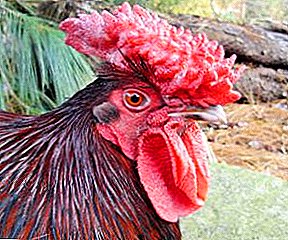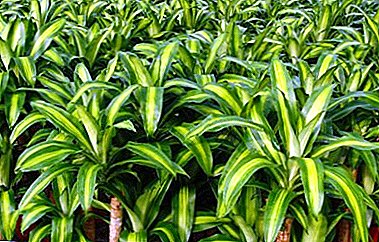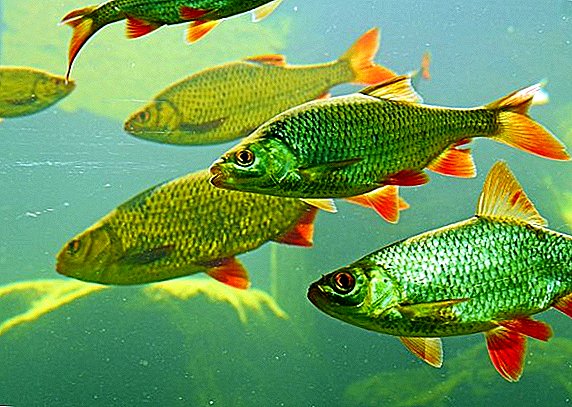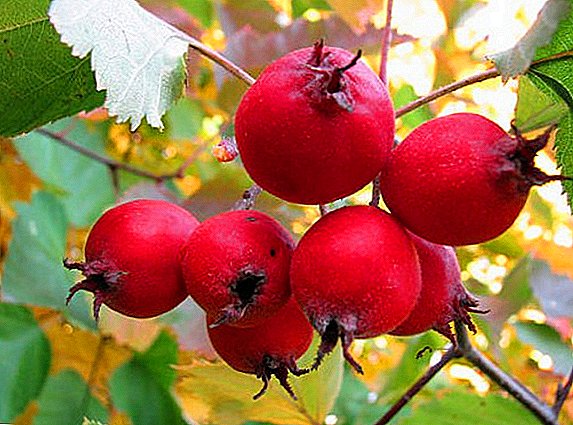 Having planted hawthorn in your compound, you will receive not only a decorative element in landscaping, but also a storehouse of healing raw materials. With high-quality seedlings and well-chosen place for planting care for this plant will be reduced to an elementary minimum.
Having planted hawthorn in your compound, you will receive not only a decorative element in landscaping, but also a storehouse of healing raw materials. With high-quality seedlings and well-chosen place for planting care for this plant will be reduced to an elementary minimum.
Where and how to plant hawthorn, what you need to know to create a hedge, how to harvest useful inflorescences and fruits - we will tell about all this later in the article.
Choosing a place
A characteristic feature of this unpretentious plant is the ability to adapt to any conditions. The tree will grow in the sun and in the shade. There are many shade-tolerant hybrids. You can recognize them by the color of the leaf plates: the darker they are, the easier the culture tolerates the absence of ultraviolet radiation.
If you plan to decorate your garden with delicate flowers, and even harvest the harvest, the choice should be made in favor of the solar plot. Strong wood of young and mature seedlings does not get burns even with a long stay in direct sunlight.
Especially favorably they affect variegated varieties, which in the shade lose their color and turn green. Far from the sun, any kind of hawthorn will flaunt only foliage, and you will not see flowers and fruits. 
Did you know? They cultivated the plant so long ago. They looked at the tree for a long time, initially it was grown exclusively as an ornamental. The French managed to break down these stereotypes, the first to start mass cultivation for harvesting medicinal berries. Today, this tradition was intercepted by China, Turkey, Algeria and the Mediterranean countries, which are considered to be the largest producers of hawthorn.
In addition to lighting, it is important to take into account the peculiarities of the soil composition and its acid reaction. The plant prefers enriched in humus, neutral or slightly alkaline substrates. Although it can even adapt to heavy loam and poor sandstones, in this case, inhibition of development is inevitable. 
Experts say that the land with excess calcium is successful for hawthorn planting. If that is not available, you will have to make adjustments. Avoid the acidic environment, where during rains and thaw water stagnates and cold air collects.
Important! Ideal for hawthorn is a soil mixture prepared from equal parts of peat, hardwood or sod land, river sand, lime and humus.
Selection of seedlings
A healthy seedling is distinguished by a well-developed strong root system, a smooth, even trunk with 3-5 skeletal branches. To determine the quality of hawthorn, carefully examine it, paying attention to the description below:
- Roots should be fresh and well branched, with no nodules, galls, suspicious stains, mold and putrefactive areas. To check them, slightly scratch the lower processes - on suitable for planting specimens, fresh wood will appear at the site of damage.
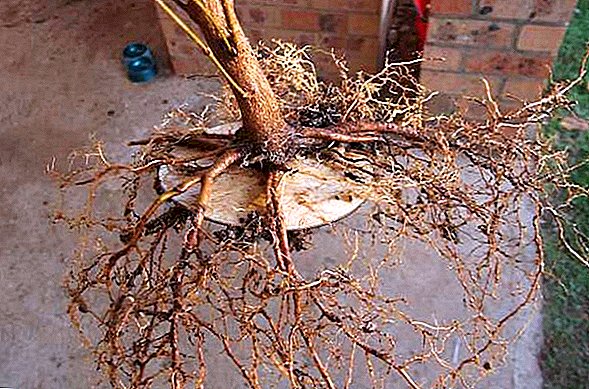
- The trunk can be called qualitative if there are no mechanical damages and incomprehensible tumors on it, its bark is even and smooth.
- Plant height should vary within one and a half meters. Too tall samples take root poorly, get sick and sit for a long time without growth.
- For rooting an excellent material are seedlings of 3 years of age. Trees that are more than 4 years old are not recommended to be replanted, as hawthorn has very deep rhizomes. Exceptions are specimens grown in large garden containers. When planting containers simply break open, so as not to damage the root system of the plant.

Did you know? Ancient Greek mediums believed in the witch force of hawthorn. The prickly branches of this culture could be seen above each entrance door. It was believed that this attribute scares away demons and other evil spirits, leading to illness and failure.
For long-term transportation, the root part of the acquired planting material is wrapped with a damp cloth and polyethylene. Alternatively, you can cover the wet substrate in a small plastic bag and place a seedling in it. The latter option will ensure plant vitality for several days.
How to plant hawthorn
Hawthorn is considered a very unpretentious plant, its cultivation and care in pleasure even to the most busy and lazy gardeners. This is the case when you can plant a tree and remember it only periodically, when it comes time to harvest the fruit. We will understand how to properly organize planting plants.
Learn about popular hawthorn breeding methods at home.
Timing
Many prefer to realize the rooting of seedlings in the spring, when stable warm weather is established outside and the earth warms up sufficiently. This period begins somewhere in the second decade of April. It is believed that such specimens grow up quickly, form powerful roots and build up lush biomass. These inclinations help a tree or shrub easier to winter.
Important! If you add a well-known fuzz when planting hawthorn, add material 2-3 weeks before rooting the seedling, be sure to mix it with the substrate, then pour it. Otherwise, the roots will get severe burns.
Others are convincing of the greater benefits of autumn planting, since the young sapling, hitting the ground, has enough time to gain a firm hold before the onset of cold weather and grow into the ground. And even more so hawthorn, which is famous for its long powerful roots. With the onset of heat, such patterns are rapidly growing. In this case, the landing should be planned in mid-October, a few weeks before the first frost.
Experts share the opinion of those and others. In their opinion, the landing period is not particularly significant for hawthorn. The main thing is that the earth was not cold, and the weather allowed the plant to adapt to new conditions. It is also noted that spring plantings require regular moistening of the pristvolny holes in order to protect the seedlings from drying out.
Site preparation
The preparatory stage in the process of planting hawthorn is perhaps equally important in choosing a suitable site and high-quality planting material. It begins in advance. Approximately one month before rooting.
Important! When frozen, hawthorn fruits lose tannins, as a result of which astringency on taste disappears.
First of all, the area where hawthorn will grow in the future, you need to dig up.
 Then test the ground withdrawn from the 20-centimeter depth for acidity. At home, it is quite possible to do with ordinary table vinegar. A couple of drops of liquid drip on a small soil ball. Hiss and foaminess indicate an alkaline environment.
Then test the ground withdrawn from the 20-centimeter depth for acidity. At home, it is quite possible to do with ordinary table vinegar. A couple of drops of liquid drip on a small soil ball. Hiss and foaminess indicate an alkaline environment.
You will be interested to know what types of soil there is and how you can determine its acidity.
If necessary, soil can be deoxidized with dolomite flour, lime, cement dust or old plaster. The amount of substance introduced depends on the degree of oxidation. On average, per 1 square meter will need from 150 to 300 g of powder.
When the terrain is prepared, you can start digging a recess for landing. Its size is more proportionally dependent on the root system. The plant in the pit should not be cramped and too spacious. On average, the ratio of the width and height of the hole should be within 70 cm.
Important! When preparing the landing pit, lay the top layer of earth on a separate slide. It is useful for the preparation of soil mixture, which fall asleep roots.
Lay a layer of drainage on the bottom, in the role of which expanded clay, gravel, brick chips or broken ceramic tiles can play, fill the deepening with a fertile substrate for a third.
After the manipulations, cover this place with plastic wrap, securing its edges. By the time of planting, the microflora required for fruit culture will be formed in the pit.
Landing patterns
Planting is carried out in prepared pits so that its root collar is at ground level. Do not forget to pre-straighten the rhizome, pour it and thoroughly tamp the soil in the pit.
Some gardeners with this purpose specifically shake the seedling, while filled up the voids formed in the roots. At the end of all the work, the trunks of the wells are re-moistened, covered with a thin layer (up to 5 cm) of peat or other mulch.
When planning a landing, consider hawthorn crown volumes. In single landings, experts advise retreating from the trunks of neighboring plants up to 2 m. And if you conceived to create a living hedge from thorny bushes, you need to compact them with gaps of 15-20 cm.
For these purposes, land owners prefer single-pest and prickly hawthorn species. To the best of their branching shoots need to be twisted.
Important! Material from coniferous crops is not suitable as hawthorn mulch. The fact is that during decomposition it promotes the oxidation of the soil, which adversely affects the plant.
There is an alternative way to bookmark a hedge. It consists in rooting seedlings at a distance of half a meter each other in specially prepared trenches.
How to care for hawthorn
The plant does not require special care and special knowledge. It is possible to improve its appearance and fruiting by regular processing and moistening of the soil, periodic feeding and trimming. We will understand in more detail the main secrets of gardeners.
Watering, weeding and loosening
When hawthorn roots get too much water, the risk of developing putrefactive processes increases. Culture does not require frequent watering at all, since most of its species tolerate drought well. Their root system develops deep enough to feed the trunk with nutrients and moisture.
Therefore, mature trees can not be watered, but young seedlings need additional attention. Plants moisturize only during periods of lack of rain, pouring about 2-3 buckets of settled water under each barrel. 
Important! In order for the hawthorn to bloom abundantly, and its greenfinches will not crumble, the plant will need to be watered additionally during the budding period, especially this recommendation is relevant during the dry summer period.
Regardless of the age of the hawthorn, it is imperative to clean the weeds around the planting in time, loosen and mulch the soil. Together, these works contribute to better aeration and nutrition of the roots, do not allow moisture to evaporate, and improve the aesthetic appearance of the garden.
Top dressing
Frankly, this procedure for hawthorn apply only caring owners who have free time. The culture is unpretentious, so it can do without fertilizers, but in this case, there are obvious signs of slower growth of shoots and deterioration of decorativeness. 
Supplemental nutrition is desirable for all large-fruited varieties. To stimulate the harvest, the first time they are fed in early spring, the second - when the hawthorn blooms, and the third - during the ripening of the berries.
Two-time fertilizer is recommended for decorative variegated forms. It is conducted in spring and autumn. In all cases, solutions of organic substances are poured at the root, for which chicken manure, mullein, humate and compost are ideal. Also, a handful of urea dissolved in a bucket of water or mineral complex substances will not interfere. Ideally, fertilizers alternate.
Did you know? Celtic people were afraid of hawthorn and never planted it in private farmsteads. It was believed that from the plant appear boils, swelling and all sorts of tumors. For a long time it was associated with darkness and evil.
Pest and disease control
In a temperate climate conditions, hawthorn is threatened: butterfly-boyar, deciduous moth, silkworm, apple sucker and aphid, which lay eggs on foliage and feed on the juice of young shoots.
The plant loses its healthy appearance, its leafy plates wither and curl, and premature leaf fall begins. To save the culture from the aggressive parasite, you can use any insecticide. Aktara, Aktellik, Bi-58. New have proven themselves well.
In the case of improper care with excessive watering in the roots of the plant can start a fungal infection. Notice it is easy on the general condition of the bush or tree. Its leaves begin to wither and turn yellow.
The only method of treatment is to stop all water procedures and add any fungicide to the roots. Experts recommend: "Acrobat MC", "Abiga-Peak", "Alirin B", Bordeaux mixture, "Gamair", "Skor", "Topaz", "Fundazol".
Harvesting and storage
Most phytotherapeutists practice the treatment with inflorescences and hawthorn berries to the same extent; therefore, they recommend stocking with raw materials on time. 
Familiarize yourself with the different ways of harvesting and storing hawthorn for the winter.
Harvesting peduncles relevant at the beginning of flowering. Then scissors completely cut off floral brushes that have a sharp unpleasant aroma and bitter aftertaste. Herbalists advise to collect only fully opened flowers, avoiding buds. The fact is that during the drying process they darken, which negatively affects the chemical composition of the raw materials.
Important! Hawthorn in large quantities has an aggressive effect on the central nervous and cardiovascular systems. As a result, a person's heart rate slows down and the reaction to what is happening is severely slowed down. Therefore, for therapeutic purposes, it is recommended to take the remedy and preparations based on it in moderate dosages (within 20 drops).
The berries are cut off in the last weeks of September, when they turn completely red and soft. In some species, ripe fruits immediately begin to crumble (for example, Arnold variety). Therefore, monitor the state of the crop and try to remove it from the shrub before the onset of cold weather. In frozen berries, the amount of vitamin C is reduced, which affects their healing properties.
Prepare raw materials in dry weather. And if it rained or dew fell, wait until the plant dries. After harvesting, flower brushes and fruits are dried somewhere in the attic, away from direct sunlight. For these purposes, you can use electrical devices, setting the temperature at 40 ° C. In the latter case, the drying should be carried out for 2 hours.
It will be useful for you to learn about the healing properties of hawthorn.
Store the workpiece is recommended in tightly closed glass containers. Make sure the lid closes well, as hawthorn absorbs moisture very well. Inflorescence shelf life of 1 year, and the berries can be saved up to 2 years.
Important! People suffering from low blood pressure are not strongly recommended therapy with hawthorn preparations and infusions.
As you can see, the main secret of growing a beautiful and prolific plant is in the love and care for it. And in the case of hawthorn, an elementary minimum is enough for a magnificent hedge or a single shrub to bloom in your garden, which in the autumn will thank you for the healing fruits.






